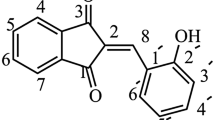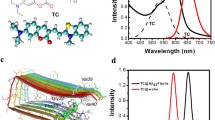Abstract
In present paper series of trimethine cyanines modified in 5,5′- or 6,6′- position with hydroxy- or methoxy- substituents is studied for their ability to interact selectively with fibrillar formations. Processes of dye aggregation that accompany this interaction were also investigated. Meso-methyl trimethynecyanines with 5,5′- methoxy (7519) and hydroxy (7515) substituents strongly (up to 40 times) increase fluorescence intensity in the presence of fibrillar insulin, and also give noticeable fluorescent response on the presence of various aggregated proteins (lysozyme, β-lactoglobulin, α-synuclein A53T). 7519 and 7515 dyes can be used for fluorometric detection of fibrillar insulin at concentrations of approximately 1.5–120 microg/ml. For meso-ethyl substituted dye 7514 the ability to form H- and J-aggregates upon interaction with insulin fibrils was suggested. The model of the H- and J-aggregate packing in the protein fibrillar structure has been proposed.










Similar content being viewed by others
References
Agorogiannis EI, Agorogiannis GI, Papadimitriou A, Hadjigeorgiou GM (2004) Protein misfolding in neurodegenerative diseases. Neuropathol Appl Neurobiol 30:215–224
Cohen FE (1999) Protein misfolding and prion diseases. J Mol Biol 293:313–320
Cohen FE, Kelly JW (2003) Therapeutic approaches to protein-misfolding diseases. Nature 426:905–909
Dobson CM (1999) Protein misfolding, evolution and disease. Trends Biochem Sci 24:329–332
Dobson CM (2003) Protein folding and misfolding. Nature 426:884–890
Harper JD, Lansbury PT (1997) Models of amyloid seeding in Alzheimer’s disease and scrapie: mechanistic truths and physiological consequences of the time-dependent solubility of amyloid proteins. Annu Rev Biochem 66:385–407
McLaurin J, Yang DS, Yip CM, Fraser PE (2000) Models of amyloid seeding in Alzheimer’s disease and scrapie: mechanistic truths and physiological consequences of the time-dependent solubility of amyloid proteins. J Struct Biol 130:259–270
Naiki H, Higuchi K, Hosokawa M, Takeda T (1989) Fluorometric determination of amyloid fibrils in vitro using the fluorescent dye, Thioflavin T1. Anal Biochem 177:244–249
LeVine H 3rd (1993) Thioflavine T interaction with synthetic Alzheimer’s disease β-amyloid peptides: detection of amyloid aggregation in solution. Protein Sci 2:404–409
Foguel D, Suarez MC, Ferrao-Gonzales AD, Porto TC, Palmieri L, Einsiedler CM, Andrade LR, Lashuel HA, Lansbury PT, Kelly JW, Silva JL (2003) Dissociation of amyloid fibrils of α-synuclein and transthyretin by pressure reveals their reversible nature and the formation of water-excluded cavities. Proc Natl Acad Sci USA 100:9831–9836
Volkova KD, Kovalska VB, Yarmoluk SM (2007) Modern techniques for protein detection on polyacrylamide gels: problems arising from the use of dyes of undisclosed structures for scientific purposes. Biotech Histochem 82(4–5):201–208
Yarmoluk SM, Kovalska VB, Lukashov SS, Slominskii YL (1999) Interaction of cyanine dyes with nucleic acids. XII. β-substituted carbocyanines as possible fluorescent probes for nucleic acids detection. Bioorg Med Chem Lett 9(12):1677–1678
Haugland RP (2005) The handbook: A guide to fluorescent probes and labeling technologies, 10th edn. Eugene, OR
Volkova KD, Kovalska VB, Balanda AO, Vermeij RJ, Subramaniam V, Slominskii YuL, Yarmoluk SM (2007) Cyanine dye–protein interactions: looking for fluorescent probes for amyloid structures. J Biochem Biophys Meth 70:727–733
Volkova KD, Kovalska VB, Balanda AO, Slominskii YuL, Tolmachev OI, Subramaniam V, Yarmoluk SM (2008) Studies of mono- and trimethine cyanine dyes as specific fluorescent probes for fibrillar β-lactoglobulin detection. Ukr Bioorg Acta 6(2):15–21
Volkova KD, Kovalska VB, Inshin D, Slominskii YL, Tolmachev OI, Yarmoluk SM (2010) Novel fluorescent trimethine cyanine dye 7519 for amyloid fibril inhibition assay. Biotechnic & Histochemistry Early Online, 1–4
Levkoev II, Sveshnikov NN, Heifetz SA (1946) Research in area of cyanine dyes. Zh Obshch Khim 16(9):1489–1494
Kiprianov AI, Dashevskaya BI (1949) Cyanine dyes from isomeric 2-methylhydroxybenzotiazoles. Zh Obshch Khim 19(6):1158–1166
Volkova KD, Kovalska VB, Segers-Nolten GM, Veldhuis G, Subramaniam V, Yarmoluk SM (2009) Explorations of the application of cyanine dyes for quantitative α-synuclein detection. Biotech Histochem 84(2):55–61
Arnaudov N, deVries R, Ippel H, vanMierlo CPM (2003) Multiple steps during the formation of β-lactoglobulin fibrils. Biomacromolecules 4:1614–1622
Crystal AS, Giasson BI, Crowe A, Kung MP, Zhuang ZP, Trojanowski JQ, Lee VMY (2003) A comparison of amyloid fibrillogenesis using the novel fluorescent compound K114. J Neurochem 86(6):1359–1368
Ahn JS, Lee JH, Kim JH, Paik SR (2007) Novel method for quantitative determination of amyloid fibrils of alpha-synuclein and amyloid beta/A4 protein by using resveratrol. Anal Biochem 367(2):259–265
Ogul’chansky TYu, Yashchuk VM, Losytskyy MYu, Kocheshev IO, Yarmoluk SM (2000) Interaction of cyanine dyes with nucleic acids. XVII. Towards an aggregation of cyanine dyes in solutions as a factor facilitating nucleic acid detection. Spectrochim Acta A 56(4):805–814
Ogul’chansky TYu, Losytskyy MYu, Kovalska VB, Yashchuk VM, Yarmoluk SM (2001) Interactions of cyanine dyes with nucleic acids. XXIV. Aggregation of monomethine cyanine dyes in presence of DNA and its manifestation in absorption and fluorescence spectra. Spectrochim Acta A Mol Biomol Spectrosc 57(7):1525–1532
Losytskyy MYu, Yashchuk VM, Lukashov SS, Yarmoluk SM (2002) Davydov splitting in spectra of cyanine dye J-aggregates, formed on the polynucleotide. J Fluoresc 12(1):109–112
Kasha M (1963) Energy transfer mechanisms and the molecular exciton model for molecular aggregates. Radiat Res 20:55–71
Krebs MRH, Bromley EHC, Donald AM (2005) The binding of thioflavin T to amyloid fibrils: localisation and implications. J Struct Biol 149:30–37
Acknowledgements
This work was supported by a STCU-NASU grant №4936. We are grateful for Professor Vinod Subramaniam (University of Twente, the Netherlands) for providing monomeric and fibrillar alpha-synuclein mutant A53T.
Author information
Authors and Affiliations
Corresponding author
Rights and permissions
About this article
Cite this article
Volkova, K.D., Kovalska, V.B., Losytskyy, M.Y. et al. Hydroxy and Methoxy Substituted Thiacarbocyanines for Fluorescent Detection of Amyloid Formations. J Fluoresc 21, 775–784 (2011). https://doi.org/10.1007/s10895-010-0770-6
Received:
Accepted:
Published:
Issue Date:
DOI: https://doi.org/10.1007/s10895-010-0770-6




